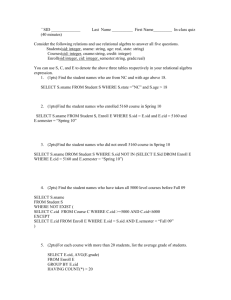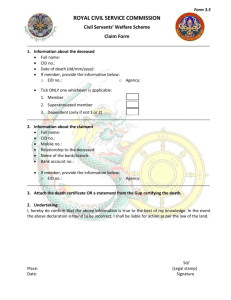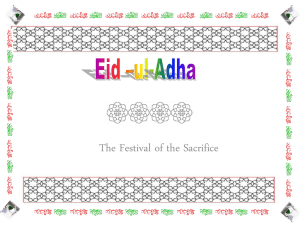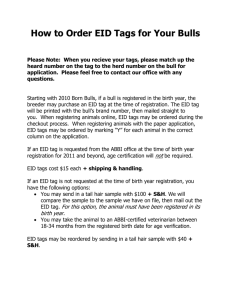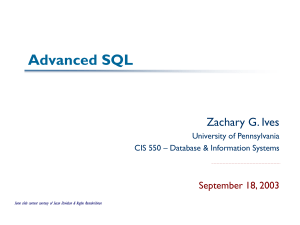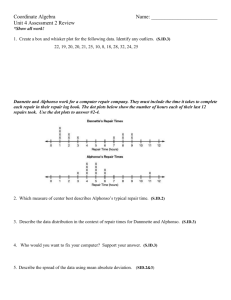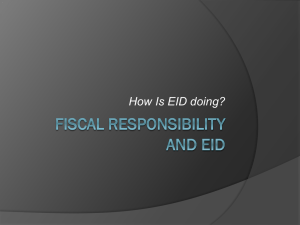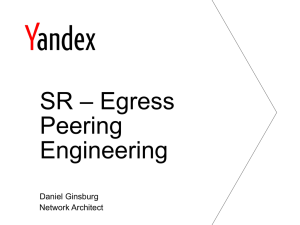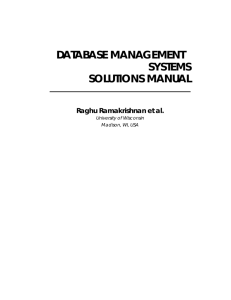MATHEMATICAL SYMBOLS
advertisement
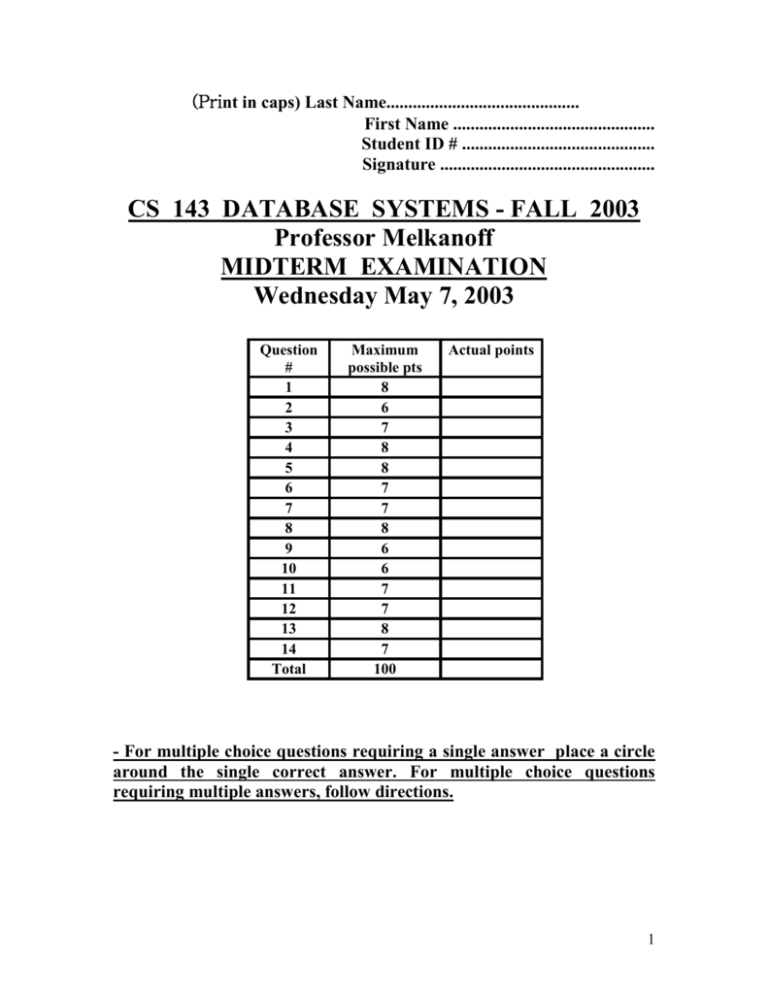
(Print in caps) Last Name............................................
First Name ..............................................
Student ID # ............................................
Signature .................................................
CS 143 DATABASE SYSTEMS - FALL 2003
Professor Melkanoff
MIDTERM EXAMINATION
Wednesday May 7, 2003
Question
#
1
2
3
4
5
6
7
8
9
10
11
12
13
14
Total
Maximum
possible pts
8
6
7
8
8
7
7
8
6
6
7
7
8
7
100
Actual points
- For multiple choice questions requiring a single answer place a circle
around the single correct answer. For multiple choice questions
requiring multiple answers, follow directions.
1
General advice:
Do not assume a query has a trivial syntactic error and therefore
produces nothing. Call the instructor if you think there is a typo
or an error.
Relations mentioned in the queries may have attributes not
mentioned, but their existence should not affect the answer.
Relations may have NULL's unless stated otherwise.
The result of SQL queries is generally a multiset, but the result of
a query in relational algebra is a set.
Initially, tables do not contain tuples unless so stated explicitly.
2
Questions 1, 2, and 3 all start from the following SQL declarations:
CREATE TABLE Emp (
eid
INTEGER PRIMARY KEY,
name CHARACTER (30),
level
CHARACTER (10));
CREATE TABLE Dept (
did
INTEGER PRIMARY KEY,
school CHARACTER (30),
mgr
INTEGER.
FOREIGN KEY mgr REFERENCES Emp(eid) ):
CREATE TABLE Works_in (
eid
INTEGER FOREIGN KEY REFERENCES Emp (eid) ,
did
INTEGER FOREIGN KEY REFERENCES Dept (did),
PRIMARY KEY (eid, did ) );
Hint: Employees work in departments and some of them also manage
departments.
Question 1 (8 points)
Draw the ER diagram from which these schemas could have been
produced.
name
Emp
level
did
eid
Works_in
school
eid
Dept
mgr
3
Question 2 (6 points)
If we add the constraint that each employee must work in at least one
department, redraw the ER diagram so as to properly reflect this
constraint.
name
did
eid
Emp
level
Works_in
school
eid
Dept
mgr
Question 3 (7 points)
Show how the additional constraint stated in Question 2 may be
included in the initial declarations.
CREATE ASSERTION AA (
CHECK NOT EXISTS
(SELECT *
FROM Emp E
WHERE E.eid NOT IN
(SELECT W.eid
FROM Works_in )) )
4
Given the following relation describing students, courses and course
enrollments:
STUDENTS ( sid, sname, major)
ENROLLED(sid, courseid, grade)
COURSES(courseid, units);
writhe the following query as indicated:
Write the names of students who are taking exactly three courses.
Question 4 (8 points)
In SQL:
SELECT S.sname
FROM STUDENTS S, ENROLLED E
WHERE E.sid = S.sid
GROUP BY E.sid
HAVING COUNT (*) = 3 ;
Question 5 (8 points)
In Relational Algebra: [USING cid FOR courseid FOR BREVITY]
E2 = E1 ⋈E1.sid=Esid⋀E1.cid<>Ecid E
ρ (C ( 2→cid1, 5→cid2), E2)
E3 = E2⋈E2.sid=E.sid⋀E2.cid<>E.cid⋀E2.cid2<>E.cid E
ρ (C ( 8 →cid3 ) E3 )
E4 = E3 ⋈E3.sid=E.sid⋀E3.cid1<>E.cid⋀E3.cid2⋀E.cid⋀E3cid3<>E.cid E
πsnane (( πsid ( E3 ) – (πsid (E4) ⋈ S )
5
The following two questions refer to the Sailors/Boats/Reserves
database described in the text and which we have been using in
class. Express the stated query in SQL.
Question 6 (7 points)
For each rating, write the number of sailors who have reserved all
the red boats.
SELECT S.rating, COUNT (*)
FROM Sailors S
WHERE NOT EXISTS (SELECT *
FROM Boats B
WHERE B.color = ‘red’
AND B.bid NOT IN (SELECT R.bid
FROM Reserves R
WHERE R.sid = S.sid))
Question, 7 (7 points)
For each date showing in Reserves, how many boats were not used?
SELECT R.daY, COUNT (DISTINCT B.bid)
FROM Reserves R, Boats B
WHERE B.bid NOT IN (SELECT R1.bid
FROM Reserves R1
WHERE R1, day = R.day)
GROUP BY R.day
6
Question 8 (8 points)
Given the following ER model diagram, write the SQL statements
which can be used to build the corresponding relational database,
combining tables as much as possible without introducing unnecessary
redundancies
p
a
d
b
A
D
B
q
E
do not include
any types for
the attributes
c
C
r
CREATE TABLE A (a, p, PRIMARY KEY (a))
CREATE TABLE BD (b, q, d, a NOT NULL, PRIMARY KEY (b)
FOREIGN KEY (a) REFERENCES A)
CREATE TABLE C (c, r, PRIMARY KEY (c))
CREATE TABLE E( a, b, c,
PRIMARY KEY (a, b, c),
FOREIGN KEY (a) REFERENCES A,
FOREIGN KEY (a) REFERENCES B,
FOREIGN KEY (a) REFERENCES C)
CREATE ASSERTION A_in_BD
CHECK NOT EXISTS (
SELECT a FROM A
WHERE a NOT IN (
SELECT a FROM BD ))
7
Question 9 ( 6
points)
Given the following three relations
R (a, b) = {<1, 3>, <3, 3>, <5, 6>, <6, 3>}
S (b, c) = {<2, 4>, <3, 4>, <3, 8>, <6, 4>, < 6, 8>}
T (c, d) = {<4, 4>, <4, 8>, <5, 4>, <8, 9>}
The number of tuples in R ⋈ S ⋈ T where ⋈ is the natural join is:
(a) 4
(b) 6
(c) 12
(d) 13
Question 10 ( 6
points)
Place a check mark next to all the equations below which hold true for
sets, but not necessarily for multisets, a cross for those that hold for
both and leave blank otherwise.
R
R
R
R
∩(S∩R)
∩(S∩R)
∪ ( S ∩ R)
∪ ( S ∩ R)
=
=
=
=
(
(
(
(
R
R
R
R
∩S)∩R
∩S)∩S
∪S)∩R
∪S)∩S
........
.........
........
...........
8
Question 11 ( 7
points)
Consider the following three schema declarations. You may assume that
all columns have the same type which has been omitted for brevity.
Schema 1: CREATE TABLE R(A PRIMARY KEY, B)
CREATE TABLE S(C, D REFERENCES R(A));
Schema 2: CREATE TABLE R(A PRIMARY KEY, B)
CREATE TABLE S(C, D CHECK ( D IN SELECT A
FROM R )));
Schema 3: CREATE TABLE R(A PRIMARY KEY, B)
CREATE TABLE S(C, D)
CREATE ASSERTION Assert CHECK(
NOT EXISTS (SELECT * FROM S
WHERE D NOT IN (SELECT A
FROM R)));
Which of the following statements is true? (Circle one only.)
(a)All three schemas are equivalent in terms of their behavior.
(b) Schemas 1 and 2 are equivalent but schema 3 is different.
(c) Schemas 1 and 3 are equivalent but schema 2 is different.
(d) Schemas 2 and 3 are equivalent but schema 1 is different.
(e) None of the three schemas are equivalent.
9
Question 12 ( 7 points)
In SQL 3-valued logic the value of the expression
R.a > R.b AND R. a <= 0 AND R.b >=0
can be
(a) only TRUE or FALSE
(b) only FALSE or UNKNOWN
(c) only TRUE or UNKNOWN
(d) Any of TRUE, FALSE, or UNKNOWN
Condition A: R.a > R.b Condition B: R.a <= 0 Condition C: R.b >= 0
A = T, whereby B = F and C = F, or
A = F, whereby B = T and C = T, or
A = U, whereby B = U and C = U
a
b
a AND b
A OR b
TRUE
TRUE
TRUE
TRUE
TRUE
FALSE
FALSE
TRUE
TRUE
UNKNOWN
UNKNOWN
TRUE
FALSE
TRUE
FALSE
TRUE
FALSE
FALSE
FALSE
FALSE
FALSE
UNKNOWN
FALSE
UNKNOWN
UNKNOWN
TRUE
UNKNOWN
TRUE
UNKNOWN
FALSE
FALSE
UNKNOWN
UNKNOWN
UNKNOWN
UNKNOWN
UNKNOWN
As may be seen from the Truth table, a AND b can only be true when both a
and b are true. Since this is impossible, the only possible values for the
expression are FALSE or UNKNOWN.
10
Question 13 (8 points)
Given the following ER model diagram, write the necessary SQL
declarations combining tables as much as possible without excessive
redundancies.
q
p
a
A
D
B
b
d
CREATE TABLE ABD (
a, b, p, q, d,
UNIQUE (a),
PRIMARY KEY (b) )
11
Question 14 (7 points)
Q1:
SELECT R1.a, R3.a
FROM R R1, R R2 , R R3
WHERE R1.a = R2.a AND R2.b = R3.b AND R1.b <> R2.b;
Q2:
SELECT R1.a, R3.a
FROM R R1, R R2, R R3
WHERE R1.b = R2.b AND R2.a = R3.a AND R2.b <> R3.b;
(a) Q1 and Q2 produce the same answer.
(b) The answer to Q1 is always contained in the answer to Q2.
(c) The answer to Q2 is always contained in the answer to Q1.
(d) Q1 and Q2 produce different answers.
The only difference between Q1 and Q2 is an exchange of labels
between R1 and R3.
12



